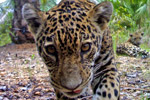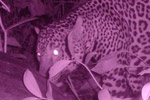Jaguars (Panthera onca) are the biggest cat in the Americas and the only member of the Panthera genus in the New World; an animal most people recognize, the jaguar is also the third largest cat in the world with an intoxicatingly dangerous beauty. The feline ranges from the harsh deserts of southern Arizona to the lush rainforests of Central America, and from the Pantanal wetlands all the way down to northern Argentina. These mega-predators stalk prey quietly through the grasses of Venezuelan savannas, prowl the Atlantic forests of eastern Brazil, hunt along the river of the Amazon, and even venture into lower parts of the Andes. However, in 40% of the jaguar’s original range the big cat has vanished completely. Population numbers are also down in Mexico, Central America, parts of Brazil, Argentina, Venezuela and the Guianas. The good news is in the Peruvian Amazon: here, the jaguar is doing fine, still very much king of the jungle. In fact, a recent paper in Biological Conservation by the AREAS Amazonian Project found that the jaguar population in three Peruvian conservation areas could number as high as 6,000 animals with densities rivaled only by the Pantanal.
Carried out by camera trapping, the study is one of only a handful on jaguar populations, since these large animals are by no means easy to find.
“Jaguars are wide-ranging and logistics strangle the movements of researchers…jaguars are smart, particularly females, and make capture very difficult. A researcher working in the Amazon, especially away from rivers, can go for years without seeing one of his/her jaguars, so observing behavior has not been possible,” George Powell of AREAS Amazonia Project told mongabay.com. “Most jaguar work in the Amazon basin has been completed in the floodplains of the Amazon, a habitat type that represents only 15% of the Amazon basin. And this goes not only for jaguars, but also for other large mammal studies.”
Powell, with the World Wildlife Fund, is working with Mathias Tobler with San Diego Zoo Global and others on the ambitious and far-reaching AREAS Amazonia Project.

Jaguar caught on camera trap for the AREAS Amazonia Project. Photo by: WWF & San Diego Zoo.
“The overriding objective of the project is to determine area and habitat requirements for the maintenance of a viable ecosystem in the western Amazon,” Powell explains, noting that the focus is on two species: jaguar and white-lipped peccaries (Tayassu pecari). Scientists chose these two, because both require large areas and are especially sensitive to habitat destruction and other human pressures. To conservation planners they are known as umbrella species. In other words, if a landscape is large enough for jaguars and white-lipped peccaries, it will likely support most other mammals.
To count jaguars and white-lipped peccaries, scientists placed camera traps in four widely separated study areas in the largely intact forest of the Madre de Dios region in southern Peru.
The area contains a large number of protected areas—National Parks, Indigenous Reserves, private conservation concessions and forestry concessions that allow only selective logging—but as humans continue to press into this primeval forest in growing numbers, these protected areas will become more and more isolated from each other. Forestry concessions, where some timber harvesting is allowed, may prove vital as corridors connecting national parks and other conservation areas together. None of the individual conservation areas are, by themselves, large enough to support the continuation of jaguars in the region, making connectivity vital.
The results of the study are cautiously encouraging; the populations are healthy with numbers higher than expected, including an estimate of around 6,000 jaguars in three of the study areas.

White-lipped peccaries on camera trap for the AREAS Amazonia Project. White-lipped peccaries can live in herds up to several thousand individuals. Photo by: WWF & San Diego Zoo.
“Our results indicate that there are more females than males in our populations,” says Mathia Tobler. “This is good news since the number of breeding females is usually the limiting factor in a population. Males travel over larger areas and can mate with multiple females.”
The research is pioneering new ways of collecting data on jaguars. An earlier study in the area adjacent to the one in Madre de Dios found smaller population numbers. While this could be due to higher hunting of jaguars and their prey species, it could also be due to more rigorous research methods, including more camera traps used in the current study.
“[Jaguars] are hard to observe and following them by radio telemetry in a dense forest with no roads is almost impossible. Only recently technologies such as camera traps and GPS collars became available that now allow us to better study this species,” Tobler explains.
Right now, the research is still preliminary and needs to be continued and expanded. In the future, the project hopes to look at indigenous reserves as well as the longer-term effects of logging and other impacts on the region. For the present though, the survival of the jaguar in the Amazonian lowlands looks good. With the continued dedication of researchers like those in the AREAS Amazonia Project, we can hope that the big cat continues to be king of one of the most biodiverse areas on the planet.
CITATION: Tobler, M.W., Carrillo-Percastegui S.M., Hartley A.Z., and Powell G.V.N. 2013. High jaguar densities and large population sizes in the core habitat of the southwestern Amazon. Biological Conservation 159: 375-381.
Related articles
Jaguars, tapirs, oh my!: Amazon explorer films shocking wildlife bonanza in threatened forest

(02/19/2013) Watching a new video by Amazon explorer, Paul Rosolie, one feels transported into a hidden world of stalking jaguars, heavyweight tapirs, and daylight-wandering giant armadillos. This is the Amazon as one imagines it as a child: still full of wild things. In just four weeks at a single colpa (or clay lick where mammals and birds gather) on the lower Las Piedras River, Rosolie and his team captured 30 Amazonian species on video, including seven imperiled species. However, the very spot Rosolie and his team filmed is under threat: the lower Las Piedras River is being infiltrated by loggers, miners, and farmers following the construction of the Trans-Amazon highway.
Chasing down ‘quest species’: new book travels the world in search of rarity in nature

(02/13/2013) In his new book, The Kingdom of Rarities, Eric Dinerstein chases after rare animals around the world, from the maned wolf (Chrysocyon brachyurus) in Brazil to the golden langur (Trachypithecus geei) in Bhutan to Kirtland’s warbler (Setophaga kirtlandii) in the forests of Michigan. Throughout his journeys, he tackles the concept of rarity in nature head-on. Contrary to popular belief, rarity is actually the norm in the wildlife world.
Can ranchers co-exist with jaguars?

(01/17/2013) Jaguar once roamed from the United States to Argentina, but today they’ve been eliminated from several range countries, including the United States. The chief reasons are habitat loss and direct killing by humans, putting ranchers and farmers at the heart of the issue. Both ranchers and farmers convert key jaguar habitat and kill the big cats as a threat to their livestock. However in parts of Brazil’s Pantanal, some ranchers are going about their business without killing jaguars. My Pantanal, a film by Andrea Heydlauff, Vice President of the wild cat conservation group Panthera, takes a look at one particular ranch that is helping prove that jaguars and ranchers can co-exist.
Jaguar conservation gets a boost in North and Central America

(09/27/2012) Jaguar conservation has received a huge boost in the past few months both in Latin America and in the U.S. An historic agreement singed between the world’s leading wild cat conservation organization Panthera and the government of Costa Rica in addition to a new U.S. Fish and Wildlife Service (FWS) proposal bring renewed hope to the efforts to revive the iconic jaguar in its current habitat and return the cats to the American Southwest.
Key mammals dying off in rainforest fragments

(08/15/2012) When the Portuguese first arrived on the shores of what is now Brazil, a massive forest waited for them. Not the Amazon, but the Atlantic Forest, stretching for over 1.2 million kilometers. Here jaguars, the continent’s apex predator, stalked peccaries, while tapirs waded in rivers and giant anteaters unearthed termites mounds. Here, also, the Tupi people numbered around a million people. Now, almost all of this gone: 93 percent of the Atlantic Forest has been converted to agriculture, pasture, and cities, the bulk of it lost since the 1940s. The Tupi people are largely vanished due to slavery and disease, and, according to a new study in the open access journal PLoS ONE, so are many of the forest’s megafauna, from jaguars to giant anteaters.
Jaguars photographed in palm oil plantation

(06/06/2012) As the highly-lucrative palm oil plantation moves from Southeast Asia to Africa and Latin America, it brings with it concerns of deforestation and wildlife loss. But an ongoing study in Colombia is finding that small palm oil plantations may not significantly hurt at least one species: the jaguar. Researchers in Magdalena River Valley have taken the first ever photos of jaguars in a palm plantation, including a mother with two cubs, showing that the America’s biggest cat may not avoid palm oil plantations like its Asian relative, the tiger.
Jaguar v. sea turtle: when land and marine conservation icons collide

(05/16/2012) At first, an encounter between a jaguar (Panthera onca) and a green sea turtle (Chelonia mydas) seems improbable, even ridiculous, but the two species do come into fatal contact when a female turtle, every two to four years, crawls up a jungle beach to lay her eggs. A hungry jaguar will attack the nesting turtle, killing it with a bite to the neck, and dragging the massive animal—sometime all the way into the jungle—to eat the muscles around the neck and flippers. Despite the surprising nature of such encounters, this behavior, and its impact on populations, has been little studied. Now, a new study in Costa Rica’s Tortuguero National Park has documented five years of jaguar attacks on marine turtles—and finds these encounters are not only more common than expected, but on the rise.